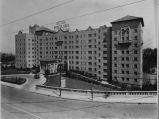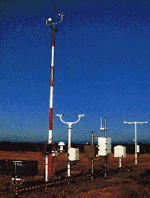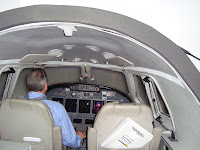
I have a good friend and HUGE Girls With Wings supporter in a neighbor of mine, Carol. She is always finding articles that I might be interested in and dropping them off. The other day, it was a Cleveland Plain Dealer article on the "
Pink Palace." Of course, this picture to the right, taken in 1979, doesn't show the salmon-ish color that it has been since it was built in the 1920s. This residential hotel used to be quite the gathering spot, luxurious by any standards with ballrooms, supplied and supervised servants, games and activities, etc. In fact, "there was so much activity that the 400-room residential hotel even had its own weekly glossy magazine, 10 or 12 pages an issue, called From the Windows of Westlake."
Ok, so why would my neighbor think this article would be of interest to me? Because it mentions that the hotel...

...had become a convenient favorite for people connected to the new aviation industry. The hotel became a must stop for aviators, as well as others involved in the airline business; it also served as headquarters for the leading women's flying clubs, including the
Ninety-Nines (The
Ninety-
Nines, Inc, International Organization of Women Pilots is a non-profit organization established in 1929 and still going strong today) and the Betsy Ross Aviators (Organized early in 1931, prepared to fly hospital ships, carry dispatches, transport refugees, and take over the civilian flying jobs to release men for combat -
NewYorker story).
Amelia Earhart, a frequent guest, was interviewed at the hotel in 1935. She commented on a lucky charm given her for an upcoming long flight: "I think a good mechanic is much better than a lucky charm."
lucky charm given her for an upcoming long flight: "I think a good mechanic is much better than a lucky charm."
Other aviators who visited included James H. Doolittle Jr., Wiley Post and Charles Lindbergh, though whether Lindbergh stayed overnight is uncertain.
But in the days before night flying, the Westlake was the place for pilots to sleep over -- it was the closest hotel to Cleveland Municipal Airport (not yet named Hopkins). Many of them recognized the building from their planes, since the 20-foot-high sign on the Westlake's roof created a marker visible at an elevation of 4,000 feet.
 Adding to the glamour quotient, a number of stewardesses (as they were then known) lived here, and some airlines also kept suites for employee layovers.
Adding to the glamour quotient, a number of stewardesses (as they were then known) lived here, and some airlines also kept suites for employee layovers.
Tom Barrett, a longtime Rocky River resident and member of the historical society, says his aunt, Jeanette Curtis, lived at the Hotel Westlake with two stewardess roommates in the '40s.
"It was a safe place, convenient to the airport, and there really weren't other reputable hotels on the West Side at the time," he says.
In October 1929, for instance, the Westlake's newsletter reported that "Skyways Inc. has two of its most able men living in one of the bachelor apartments," and further that a Mr. H.L. Kindred, operations manager and vice president of Continental Airlines, and his family "were making the Westlake their Cleveland home."
 So I bring all this up because of the National Air Races, a series of pylon and cross-country races that took place from 1920 to 1949. The science of aviation, and the speed and reliability of aircraft and engines grew rapidly during this period; the National Air Races were both a proving ground and showcase for this.
So I bring all this up because of the National Air Races, a series of pylon and cross-country races that took place from 1920 to 1949. The science of aviation, and the speed and reliability of aircraft and engines grew rapidly during this period; the National Air Races were both a proving ground and showcase for this.
In 1920 publisher Ralph Pulitzer sponsored the Pulitzer Trophy Race for military airplanes at Roosevelt Field, Long Island, New York, in an effort to publicize aviation and his newspaper. The races eventually moved to Cleveland and then they were known as the Cleveland National Air Races. They drew the best flyers of the time, including James Doolittle, Wiley Post, Frank Hawks, Jimmie Wedell, Roscoe Turner, and others from the pioneer age of aviation.
The races usually ran for up to 10 days, usually at the end of August. During World War II the races were on hiatus.
The races included a variety of events, including cross-country races that ended in Cleveland, landing contests, glider demonstrations, airship flights, and parachute-jumping contests. The most popular events were the Thompson Trophy Race, a closed-course race where aviators raced their planes around pylons, and the Bendix Trophy Race across most of the USA.
In 1929 Cleveland was the venue for the first Women's Air Derby, which developed into the Powder Puff Derby, that featured well-known female pilots such as Amelia Earhart, Pancho Barnes, Bobbi Trout, and Louise Thaden.
When the races resumed after World War II, they featured newer surplus military planes that greatly outclassed the planes from the pre war era. In 1949 Bill Odom lost control of his P-51 "Beguine" and crashed into a home, killing himself and two people inside. The races went on hiatus again.
The annual event resumed in 1964 as the Reno National Championship Air Races, taking place in mid-September. [Courtesy Wikipedia]
 For the full history on the Air Race, please go to this page on the Cleveland Air Show website and this page to read specifically about the 1929 Women's Air Race, dubbed the Powder Puff Derby by Wiley Post. The page on the 99s website was written by Gene Nora Jensen, author of one of my favorite books, THE POWDER PUFF DERBY OF 1929.
For the full history on the Air Race, please go to this page on the Cleveland Air Show website and this page to read specifically about the 1929 Women's Air Race, dubbed the Powder Puff Derby by Wiley Post. The page on the 99s website was written by Gene Nora Jensen, author of one of my favorite books, THE POWDER PUFF DERBY OF 1929.
The reason I bring this all up is because for 20 years Cleveland was the center of aviation pagentry. And now, the most visible reminder to the general public is the train station in the basement of the Cleveland Hopkins Airport. Is it a reminder to me every time I go to and from my job as a professional pilot, how "far" we've come. If you've read my tweets
and blog, you will know that I think CLE has such a

disappointing airport, though they are going thru some renovations UPSTAIRS they should spend a little effort cleaning up the first impression visitors will have to Cleveland as the transit from the airport to route to many other destinations, like downtown.
Plus it just makes me sad that this dirty broken tiled tribute to the Air Races is all we have left.
The hotel, btw, survived Prohibition, the Depression, and a huge fire in 1962 (which mostly just damaged the roof - validating the hotel's claim it was fireproof). During the next two decades, the hotel slipped into seediness; even the exterior was a dingy pale gray. As Barrett recalls, "It essentially became a big rooming house, and it got kind of rough." In the 80s, the hotel was renovated and turned into condos.

But in Rocky River and from the western side of Lakewood, the presence of the big pink "hotel" -- once a drawing card for movie stars, aviators and local glitterati -- still makes a head-turning statement.
It's an edifice that continues to fire the imagination -- and inspires a longing for a simpler yet somehow more sophisticated time.
Photos from
 On May 26th, the first Girls With Wings Club was successfully formed in the Minneapolis area. The Club's leader is Lindsey, at right, who is already a Girl With Wings Role Model and very active GWW volunteer. She did almost all of the work on the logistics for this event (for which I am extremely grateful) in order to arrange for a morning of training on the GWW presentation. She had connections galore, from the folks that donated the coffee and muffins for the morning session, and lunch, to a mom who is a teacher at the school where, as you can see, we were able to practice our skills to the students in the afternoon.
On May 26th, the first Girls With Wings Club was successfully formed in the Minneapolis area. The Club's leader is Lindsey, at right, who is already a Girl With Wings Role Model and very active GWW volunteer. She did almost all of the work on the logistics for this event (for which I am extremely grateful) in order to arrange for a morning of training on the GWW presentation. She had connections galore, from the folks that donated the coffee and muffins for the morning session, and lunch, to a mom who is a teacher at the school where, as you can see, we were able to practice our skills to the students in the afternoon. The participants had a great time getting to know each other and sharing their backgrounds. Most women in aviation have personal stories connected with their training experiences that form the basis of the Girls With Wings mission. The aviation industry is clearly a male dominated one, so the fact that we can illustrate to the girls (as real life examples) of successful women in aviation helps to inspire them to achieve THEIR full potential. The idea behind the interactive presentation is that we don't stand up at the front of the class and do a rote rundown of our education and training. We get in the middle of things and give the girls some individual attention!
The participants had a great time getting to know each other and sharing their backgrounds. Most women in aviation have personal stories connected with their training experiences that form the basis of the Girls With Wings mission. The aviation industry is clearly a male dominated one, so the fact that we can illustrate to the girls (as real life examples) of successful women in aviation helps to inspire them to achieve THEIR full potential. The idea behind the interactive presentation is that we don't stand up at the front of the class and do a rote rundown of our education and training. We get in the middle of things and give the girls some individual attention! We do tell the girls about ourselves, of course preferably with some insight into the rewards we find in our passion for aviation that make the hard work and study worth it, but then we give them hands-on instruction. What better "vehicle" than learning how to fly a plane is there to demonstrate to the girls that they can do anything they set their mind to? Ok, sometimes the hands on instruction is literal. How else are you going to show the girls how that attitude indicator works to show you which way your airplane is turning? This level of interaction with the girls is facilitated by speaking to the girls by themselves (with the boys off doing their own activities during this time).
We do tell the girls about ourselves, of course preferably with some insight into the rewards we find in our passion for aviation that make the hard work and study worth it, but then we give them hands-on instruction. What better "vehicle" than learning how to fly a plane is there to demonstrate to the girls that they can do anything they set their mind to? Ok, sometimes the hands on instruction is literal. How else are you going to show the girls how that attitude indicator works to show you which way your airplane is turning? This level of interaction with the girls is facilitated by speaking to the girls by themselves (with the boys off doing their own activities during this time). All of the girls were wonderful but there was one girl in particular who made an impression on me. She is shown at left in her wheelchair and every picture I have from the event shows her so riveted on the presentation. I am so glad that I thought to go up to her afterward and tell her about AbleFlight, an organization that offers people with disabilities a unique way to challenge themselves through flight training, and by doing so, to gain greater self-confidence and self-reliance. Her face lit up like the sun!
All of the girls were wonderful but there was one girl in particular who made an impression on me. She is shown at left in her wheelchair and every picture I have from the event shows her so riveted on the presentation. I am so glad that I thought to go up to her afterward and tell her about AbleFlight, an organization that offers people with disabilities a unique way to challenge themselves through flight training, and by doing so, to gain greater self-confidence and self-reliance. Her face lit up like the sun!






























